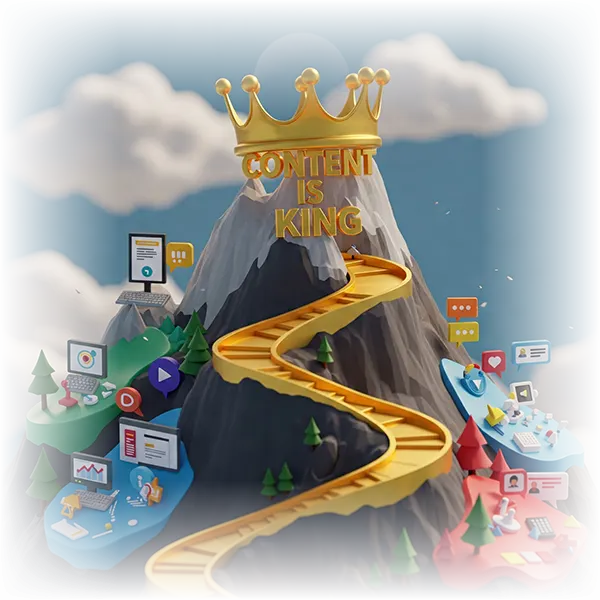Imagine this: it's 2003, and you’re staring at your first website; the thrill of publishing your thoughts and ideas online is palpable. Fast forward twenty years, and here we are, navigating a landscape where your morning coffee can be sourced from Google ads , and sales are just a click away! With insights gained from my two decades of online marketing experience, this blog post will guide you through the complex maze of online marketing and how content can be your best ally in making money online.

The Ever-Changing Landscape of Online Marketing
Online marketing is like a wild roller coaster ride. It’s thrilling, unpredictable, and sometimes makes you want to scream. But don’t worry! You’re not alone. Let’s dive into the evolution of online marketing and explore how to navigate this ever-changing landscape.
1. Understanding the Evolution of Online Marketing
Remember when online marketing was just sending out emails? Those were the days! Fast forward to today, and we have social media, content marketing , SEO , and a plethora of other strategies. The landscape has transformed dramatically.
In the early days, people were just figuring out how to use the internet. Now, it’s a bustling marketplace. Businesses have to keep up with trends, algorithms, and consumer preferences. It’s like trying to catch a greased pig at a county fair!
-
Content is Key: Quality content is king. You can’t just throw a bunch of keywords together and hope for the best. You need to engage your audience.
-
Social Media Savvy: Platforms like Facebook, Instagram, and TikTok have changed the game. You have to be where your audience is.
-
Data-Driven Decisions: Analytics is your best friend. Use data to understand what works and what doesn’t.
2. Key Players: Google and Amazon—Friends or Frenemies?
Ah, Google and Amazon. The dynamic duo of the online world. Or are they? It’s like watching a buddy cop movie where they can’t decide if they’re partners or rivals. Google wants to direct traffic, while Amazon wants to keep you shopping. It’s a classic case of “you can’t live with them, you can’t live without them.”
Google dominates search engine marketing. If you’re not on the first page of Google, do you even exist? On the other hand, Amazon is the e-commerce giant. If you want to sell products online, you better have a strategy for Amazon.
But here’s the kicker: they both rely on you, the consumer. Your behavior shapes their strategies. So, who’s really in charge here?
3. Consumer Behavior Shifts and How to Adapt
Consumers are changing faster than a chameleon on a rainbow! They want personalized experiences, instant gratification, and authenticity. If you’re still using those old-school marketing tactics, you’re going to get left behind.
Here are some ways to adapt:
-
Personalization: Tailor your content to meet the needs of your audience. If they feel special, they’ll keep coming back.
-
Engagement : Don’t just talk at your audience. Start conversations. Ask questions. Be relatable.
-
Transparency: Be honest about your products and services. Consumers appreciate authenticity.
4. Embracing New Technologies: VR, AR, and Beyond
Virtual Reality (VR) and Augmented Reality (AR) are not just for gamers anymore. They’re becoming essential tools for marketers. Imagine letting customers try on clothes virtually or experience a product before buying it. It’s like having a magic mirror, but without the evil queen!
These technologies can enhance customer experiences and drive sales. But don’t forget about the basics. Technology is just a tool. The real magic happens when you combine it with a solid marketing strategy.
So, whether you’re a seasoned pro or just starting out, remember that the
landscape of online marketing is always shifting. Stay curious, keep learning,
and don’t be afraid to try new things. After all, if Google and Amazon can
figure it out, so can you!
Finding Your Niche: The Secret Sauce to Success

So, you want to find your niche? Great! You’re not alone. Many people are on this journey, and it can feel like wandering through a maze. But don’t worry! With a little guidance, you can uncover that sweet spot where your passions meet market demand. Let’s dive in!
1. Identifying Your Target Audience
The first step is to pinpoint who you’re talking to. Think about it: if you were trying to sell ice cream, would you pitch it to someone in a winter coat? Probably not! You need to know your audience. Ask yourself:
-
Who benefits from my product or service?
-
What problems do they have that I can solve?
-
Where do they hang out online?
Use tools like Google Analytics or social media insights to gather data. You can even create customer personas. These are fictional characters that represent your ideal customers. It's like playing make-believe, but with a purpose!
2. Crafting a Unique Value Proposition
Next, let’s talk about your unique value proposition (UVP). This is your promise to your customers. It’s what makes you stand out from the crowd. Consider this:
-
What makes your product or service different?
-
Why should someone choose you over a giant like Amazon? (Seriously, it’s like David vs. Goliath!)
-
What unique benefits do you offer?
Craft a clear and compelling statement that communicates your UVP. For example, if you’re selling handmade jewelry, your UVP could be: “Each piece is crafted with love and tells a story.” It’s personal, and it connects with your audience.
3. Researching Competitors and Filling Gaps
Now, let’s get a little sneaky. Research your competitors. What are they doing well? Where are they lacking? This is your chance to swoop in and fill those gaps. Ask yourself:
-
What are customers complaining about in reviews?
-
What services or products do they wish they had?
-
How can I provide a better experience?
By identifying these gaps, you can create a niche that meets specific needs. It’s like being a superhero in your industry—saving customers from mediocre options!
4. Experimenting with Different Online Channels
Finally, let’s talk about online channels. You’ve got options! From social media to email marketing, the digital world is your oyster. But how do you know where to focus your efforts?
Start experimenting! Test different platforms and see where your audience hangs out. Are they scrolling through Instagram, or are they more of a LinkedIn crowd? You might find that one channel works better than others.
Remember, it’s all about trial and error. Don’t be afraid to mix it up. You might even discover that TikTok is the place to be for your niche. Who knew dancing cats could sell products? Well, they do!
In the end, finding your niche is like baking a cake. You need the right ingredients, a dash of creativity, and a sprinkle of research. So roll up your sleeves and get to work. Your secret sauce awaits!
Content is King: Strategies that Actually Work

In the vast ocean of the internet, content reigns supreme. But not just any content—*valuable* and *engaging* content. You might be wondering, "What does that even mean?" Well, let’s break it down.
1. Creating Valuable and Engaging Content
First things first: your content needs to be valuable. What does that mean? It means it should provide something useful to your audience. Think of it as a gift. Would you give someone a gift that they don’t want? Of course not! So, why would you create content that doesn't resonate with your audience?
-
Identify your audience: Know who you’re talking to. Are they young entrepreneurs? Busy moms? Tech-savvy teens? Tailor your content to their interests.
-
Answer their questions: People love answers. If you can solve a problem or provide insights, they’ll keep coming back. Think of it as being the wise old sage in a world of confusion.
-
Be relatable: Use stories, humor, and real-life examples. You know those companies like Google and Amazon? They have all the answers, but sometimes they sound like robots. Don’t be a robot. Be human!
2. Utilizing SEO Techniques to Increase Visibility
Now, let’s talk about SEO. You might think it’s just a fancy term for confusing algorithms, but it’s your best friend when it comes to getting noticed online. Imagine shouting into a crowded room. SEO is like having a microphone.
-
Keywords are key: Use relevant keywords like “online marketing” and “content marketing.” These are the breadcrumbs that lead people to your content.
-
Optimize your titles: A catchy title can draw in readers like moths to a flame. Make it engaging and relevant.
-
Meta descriptions matter: Think of these as your content’s elevator pitch. Make it compelling enough that people can’t resist clicking.
3. The Importance of Storytelling in Marketing
Have you ever noticed how a good story can captivate you? That’s because stories create connections. They make your content relatable. If you can weave a narrative into your marketing, you’ll engage your audience on a deeper level.
“Marketing is no longer about the stuff you make, but about the stories you tell.” - Seth Godin
When you share stories, you create emotional ties. This is especially true in content marketing. You’re not just selling a product; you’re inviting your audience into an experience. Remember, even Amazon started with a simple story about selling books online. Look how far they’ve come!
4. Measuring Content Effectiveness with Analytics
Last but not least, you need to measure your success. If you can’t track how your content is performing, it’s like sailing a ship without a compass. You might be moving, but where are you going?
-
Use analytics tools: Platforms like Google Analytics can show you what’s working and what’s not. It’s like having a personal trainer for your content.
-
Monitor engagement: Look at likes, shares, and comments. If people are engaging with your content, you’re on the right track.
-
Adjust as needed: Don’t be afraid to tweak your strategy. If something isn’t resonating, change it up. Even the best companies have to pivot sometimes—just ask Blockbuster!
In the ever-evolving world of online marketing, remember: content is king. By creating valuable content, optimizing for SEO, telling compelling stories, and measuring your effectiveness, you’ll reign supreme in the digital kingdom.
Making Money Online: Tips from the Trenches
So, you want to make money online? Join the club! It’s a crowded space, but don’t worry, there’s room for you yet. With over 20 years in this game, I've seen it all—trends that come and go, platforms that rise and fall, and yes, the ever-looming giants like Google and Amazon. They’re like the cool kids in school, but don’t let that intimidate you. Let’s break down how you can carve your niche!
Understanding Monetization Techniques
First up, let’s talk about monetization techniques . This is your bread and butter, so pay attention! There are several avenues you can explore:
-
Affiliate Marketing : This is where you promote someone else’s product and earn a commission for every sale made through your unique link. It’s like being a middleman but without the awkward conversations. Think of it as a referral program, but you can do it from your couch!
-
Ads: Placing ads on your website or blog can generate income. It’s like renting out space on your digital real estate. Just remember, too many ads can drive your visitors away faster than a bad date!
-
Selling Products: Whether it's physical goods or digital downloads, selling your own products can be rewarding. You create it, you sell it, and you keep the profits. Simple, right? Well, not quite. But with the right strategy, it can be!
Realizing the Dream of Passive Income Streams
Who doesn’t dream of passive income ? It sounds like a fairy tale, doesn’t it? But it's real. Imagine waking up to money in your account while you were sleeping. Sounds dreamy, right? Here’s how to make it happen:
-
Invest in digital products like e-books or online courses. Once created, they can sell themselves while you sip your coffee.
-
Utilize affiliate marketing to create a stream of income that flows even when you’re not actively working.
Just remember, passive income isn’t entirely passive at first. You’ll need to put in some hustle to set it up. But once it’s rolling, it can feel like magic!
Building a Brand that Resonates
Now, let’s chat about branding . You want to build something that resonates with people. A brand is more than just a logo; it’s the personality of your business. Think of it as your online persona. Ask yourself:
-
What values do I want to represent?
-
How can I connect with my audience emotionally?
Creating a brand that people relate to can turn casual visitors into loyal fans. And who doesn’t want fans? Just don’t be like those big companies that forget their roots. You’re not Google or Amazon—yet!
Leveraging Social Media for Sales
Social media is your best friend when it comes to online sales. Seriously! It’s like a giant marketplace where everyone hangs out. Here’s how you can use it:
-
Engage with your audience: Post regularly, reply to comments, and be genuine. People appreciate authenticity.
-
Use targeted ads: Platforms like Facebook and Instagram allow you to target specific demographics. It’s like having a bullseye on your ideal customer!
Remember, social media is not just about selling. It’s about building relationships. You’re not just a salesperson; you’re a friend they haven’t met yet. So, let your personality shine!
In the end, making money online isn’t just about the money. It’s about creating something meaningful, engaging with people, and having fun along the way. So, roll up your sleeves and get to work! The internet is waiting for you.
Bringing It All Together: Crafting Your Digital Marketing Blueprint

Creating a digital marketing blueprint is like assembling a puzzle. Each piece must fit together perfectly to reveal the bigger picture. But how do you ensure that all elements of your marketing plan work in harmony? Let’s dive into some key strategies that can help you create a cohesive marketing plan.
1. Creating a Marketing Plan That Integrates All Elements
Your marketing plan should be more than just a collection of tactics. It should integrate various elements like content marketing, social media, SEO, and email campaigns. Think of it as a well-orchestrated symphony. Each instrument has its role, and when played together, they create beautiful music.
Start by identifying your goals. What do you want to achieve? More traffic? Higher conversions? Once you know your objectives, align your strategies accordingly. For instance, if your goal is to increase online sales, consider how content marketing can drive traffic to your product pages. Remember, a disjointed plan is like a band without a conductor—chaotic and ineffective.
2. Continuous Learning and Adaptability
The digital landscape is ever-changing. What worked yesterday might not work today. So, how do you keep up? Continuous learning is key. Stay updated on industry trends, attend webinars, and read up on the latest marketing techniques. You might even find a few gems of wisdom hidden in those endless Google search results. Just be careful not to get lost in the rabbit hole—before you know it, you could end up watching cat videos instead of learning about online marketing!
Adaptability is just as crucial. If a strategy isn’t yielding results, don’t be afraid to pivot. It’s like trying to find the best route to avoid traffic. Sometimes, the GPS leads you down a road that’s a total dead end. Adjust your course and keep moving forward.
3. Utilizing Feedback to Improve Strategies
Feedback is a gift. It’s your audience telling you what they like, what they don’t, and what they want more of. Use this information to refine your strategies. For example, if your blog posts are getting lots of comments but low shares, maybe it’s time to rethink your sharing strategy.
“Feedback is the breakfast of champions.”
So, eat up!
Surveys, polls, and social media interactions can provide valuable insights. Don’t just collect feedback—act on it. This can lead to improved customer satisfaction and better engagement rates. Plus, who doesn’t love a company that listens? It’s like dating; no one wants to be with someone who only talks about themselves!
4. Balancing Organic and Paid Marketing Methods
Finally, let’s talk about the balance between organic and paid marketing. Think of it like a seesaw. If one side is too heavy, the whole thing tips over. Organic methods, like SEO and content marketing, are essential for building long-term relationships with your audience. But let’s face it—sometimes you need a little boost. That’s where paid methods come in, like Google Ads or sponsored posts on social media.
Finding the right balance is crucial. If you rely too much on paid ads, your audience might feel like they’re being bombarded. On the other hand, if you only focus on organic methods, you might miss out on immediate opportunities. It’s all about finding that sweet spot.
In conclusion, crafting your digital marketing blueprint is an ongoing journey. Embrace the learning process, adapt to changes, and listen to your audience. And remember, even giants like Google and Amazon started small. So don’t worry if you’re still figuring things out. Just keep your eyes on the prize, and who knows? You might just make money online while you’re at it! And if all else fails, there's always cat videos to keep you entertained while you strategize.



